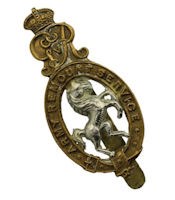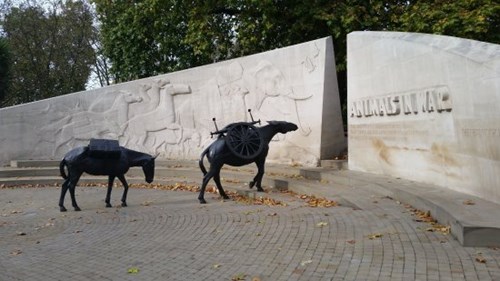The following article is published with the kind permission of the author George Wilson, Hertfordshire Constabulary Great War Society and Dr. F.R.J. Newman PhD - editor of Trench Foot Notes.
BRITISH ARMY REMOUNT SERVICE IN WWI
George Wilson
Horses have been used as an integral part of armies virtually since immemorial times; the Roman Army and Genghis Khan are two examples where cavalry played an important part in many battlefield successes. With the passage of time the value of horses for the transport of stores and equipment during conflicts also became apparent.
The American Civil War can usefully described as the precursor of the industrialisation of warfare where artillery and small arms caused a radical rethink in the prosecution of wars; the mantra that well trained cavalry, could alone win battles proved illusory. A few prescient military thinkers especially in Europe and the USA before the Great War were acutely aware of the futility of wholesale cavalry attacking ensconced artillery and infantry armed with the ubiquitous machine gun. Some military leaders chose to ignore the warning, but the first few months proved that cavalry would play a diminishing role in modern warfare.
Despite this, horses played an important role in the Great War being used especially by Great Britain and her allies on the Western Front, also in Palestine and South Africa where cavalry enjoyed some success, particularly when fighting as dismounted infantry. As the war progressed despite the extensive use of trains and the increasing use of motor vehicles, between 1914 and 1918 Britain’s war effort was dependent on its horses. Horse power was still the key method of moving the army and its supplies to destinations across Europe; the volume of military stores and rations required at the front was much greater than in any other previous conflict.
Trench warfare meant that provisions had often to be brought in from distant locations over ground unsuitable by other means of transport. Consequently there was an urgent demand for large numbers of draught and packhorses, mules and other animals. It was against this background that the raison d’etre of the Army Remount Service became a vital part of the British war effort.
Prior to 1887, the purchase of horses was the responsibility of regimental colonels in the case of cavalry regiments, or agents acting on behalf of the artillery and engineers. This system worked well enough in peacetime but rapidly broke down during wartime as demand exceeded supply. Prices rose when the Government set a limit on the cost of individual animals. The result was that regimental purchasing officers and agents were frequently left with the most inferior animals.
In 1887 the Remount Department was set up to ensure uniformity and suitability of animals purchased for the army and their training. In 1891 the service became part of the Army Service Corps, the majority of other ranks at remount depots being drawn from the ASC.
Prior to the First World War the British army possessed around 25,000 horses; by the middle of 1917 this had increased to around 600,000, plus camels and oxen. In 1911, as the prospect of a European war loomed, the Remount Department and the police conducted an inventory of horses, to enable them to select around 130,000 animals which could d be called up in an emergency. Under the Army Act of 1912 it was possible to requisition horses when needed, on payment of a fair price, subject to the owner’s right of appeal to the County Court. The majority of these horses were owned by farmers, businesses, livery yards and private owners. The Remount Service was only responsible for supplying horses and mules for use in Britain. Animals used by the Indian Army were purchased by the Indian Government, whilst those used by the British Army in the Middle East and elsewhere were bought by the local General Officer Commanding.
The Remount Statement of 1913-1914 gave the army’s detailed requirements regarding the number of horses required on mobilisation, for each command and for individual units mobilising under its orders. Over the course of the war, some 470,000 horses were purchased in the UK, with the large haulage companies and the railways being among the major suppliers. In addition around 422,000 horses and 270,000 mules came from North America, 600,000 horses and 1,500 mules from South America, plus 3,700 mules from Spain and Portugal. Between 1914 and 1920, the Remount Service spent £67.5 million on the purchase, training and delivery of animals to the various war theatres.

Remount Cap Badge
In 1914, despite the large number of horses required to supply the needs of the British Army there were only four Remount Squadrons that ran four Remount Depots located at Woolwich, Dublin, Melton Mowbray and Arborfield. Each squadron comprised about 200 soldiers, many Remount officers were drawn from the landed gentry, masters of fox hounds and others who had experience with horses in civilian life, thus avoiding withdrawing army officers from their normal duties. Such Remount officers included the well known artists Alfred Munnings, Cecil Aldin and Lionel Edwards Like so many of the support arms of the British Army during the war, the number of personnel serving with the Remount Service mushroomed: from 121 officers and 230 men in 1914, to 423 officers and 20,560 men in 1917.
Following the outbreak of hostilities, four main Remount Depots were established: Shirehampton (for horses received at Avonmouth), Romsey (for Southampton), and Ormskirk (for Liverpool). Swaythling, also located near Southampton, was a collection centre for animals being shipped abroad. Several other smaller depots were established throughout the country for the receipt of locally bred horses. The capacity and complement of each depot increased dramatically from their original establishment. For example at Swaythling in April 1919, 3,500 horses and mules were stabled and cared for by 757 men. Romsey received its 20 first horses inn March 1915; by the end of the war it had processed about 120,000, around 10% of the animals acquired by the Remount Service.
In simple terms its primary function was to train horses and mules for war service. Once the animals had joined their units they needed to be fed and watered, and if they became sick or wounded, they invariably received a high standard of veterinary care. As already mentioned horses were indispensable to the war effort on a par with artillery, machine guns and railways; the ability to mobilise vast numbers of animals was crucial. This work was fulfilled by the Horse Transport Company, the largest element of the Army Service Corps.
To support the British Army on the Western Front, a Base Remount Depot and two Advanced Remount Depots went with the BEF to the Western Front in 1914. By the end of the war there were six Remount and Advanced Remount Depots supporting the BEF, supplemented by two further Base Remount Depots at the Channel Ports (Depots were also set up in Egypt and Salonika for the campaigns in those regions).
The contribution of animals, especially to the transport services and artillery was of central importance. Horses pulled the divisional supply trains nearer to the front lines; they pulled makeshift sledges carrying the wounded over mud men could barely walk over. They took ammunition to the guns, food to the field kitchens and carried morale boosting mail to the soldiers. It is fair to say without them the ability of the British Army and her Allies to sustain four years of war fought on a truly industrial scale would have been extremely problematical.
The Daily Telegraph newspaper published on Tuesday March 11th 1919 (reproduced in the same newspaper on Monday 11th March 2019) summarised the number of horses employed by the British Army at the end of the Great War. The article said about 89,000 horses and mules were in Great Britain, 382,000 in France, 142,000 (including camels in Egypt), 59,000 in Salonika, 89,000 in Mesopotamia, 18,000 in Italy, 6,700 in East Africa, plus 17,000 newly purchased ones awaiting shipment from the USA. Except those required for the Army of Occupation, most of the horses would have to be disposed of. Up to the 10th March 1919, 28,657 had already returned to England from France.
In addition following the signing of the Armistice in November 1918, the Director Army Remount Service was told by the War Office to sell most of the horses already in the United Kingdom. By March 1920, 56,302 horses and 1,446 mules had been bought for agricultural use, for example farmers. Industrial businesses were also keen to buy horses and mules which had been well looked after by the army, in particular the Army Remount Service. It is estimated the Government received £2,000,000 from these sales.
Those animals returning from Europe were transported via the French Channel ports to Southampton, Tilbury and Hull where under the supervision of the Army Remount and Veterinary Services, they were placed in quarantine centres for fourteen days before being offered for sale in every County.
For a variety of reasons, tens of thousands of horses and mules never returned to work in Britain. Some were considered past all work and were humanely destroyed for food purposes in France. Others not considered good enough to bring back to England, but were of great value for agricultural work and industrial reconstruction in devastated areas. These animals were highly sort after. As a result the British Government received good financial remuneration from their disposal, without incurring transportation costs.
By the 1920s the British Army had returned to its pre-war establishment. The sale of horses and mules meant the need for a large Army Remount Service had ceased. During the war many of the officers and other ranks were not regular soldiers, consequently most were demobilised and returned to their previous civilian occupations. The formation was not disbanded, but with the mechanisation of the British Army during the 1930s it substantially reduced its need for horses in the Second World War. The number of animals required was relatively small and in 1942 the Army Remount Service was amalgamated into the Army Veterinary and Remount Service.
During the Great War horses and mules played a vital role in the supply and transport system to sustain the British Army and her Allies. To achieve this goal much credit rests with the men who served with the Army Remount Service. I am not aware of any specific memorial to these men. However the memorial dedicated to “Animals in War” located at Brooks Gate, Park Lane, London was unveiled by the Princess Royal, Colonel-in-Chief of the Army Veterinary Corps on 24th November 2004. The memorial is not specifically dedicated to horses or mules during Britain’s wars. It includes, dogs, oxen, elephants and carrier pigeons.

The Animals in War Memorial at Brook Gate, Park Lane, on the edge of Hyde Park
One of two inscriptions on the memorial reads: “THIS MONUMENT IS DEDICATED TO ALL THE ANIMALS THAT SERVED AND DIED ALONGSIDE BRITISH AND ALLIED FORCES IN WARS AND CAMPAIGNS THROUGHOUT TIME”
The Army Remount Service can be proud of the way horses and mules are remembered.
SOURCES:
Book: (Quinlan) British War Memorials
Websites: Imperial War Museum, National Archives, Long Long Trail, Animals in War, Wikipedia, Hoby District History Society & Daily Telegraph
Mark Quinlan: British War Memorials (Hertford: Authors on Line Ltd 2005) p.181

